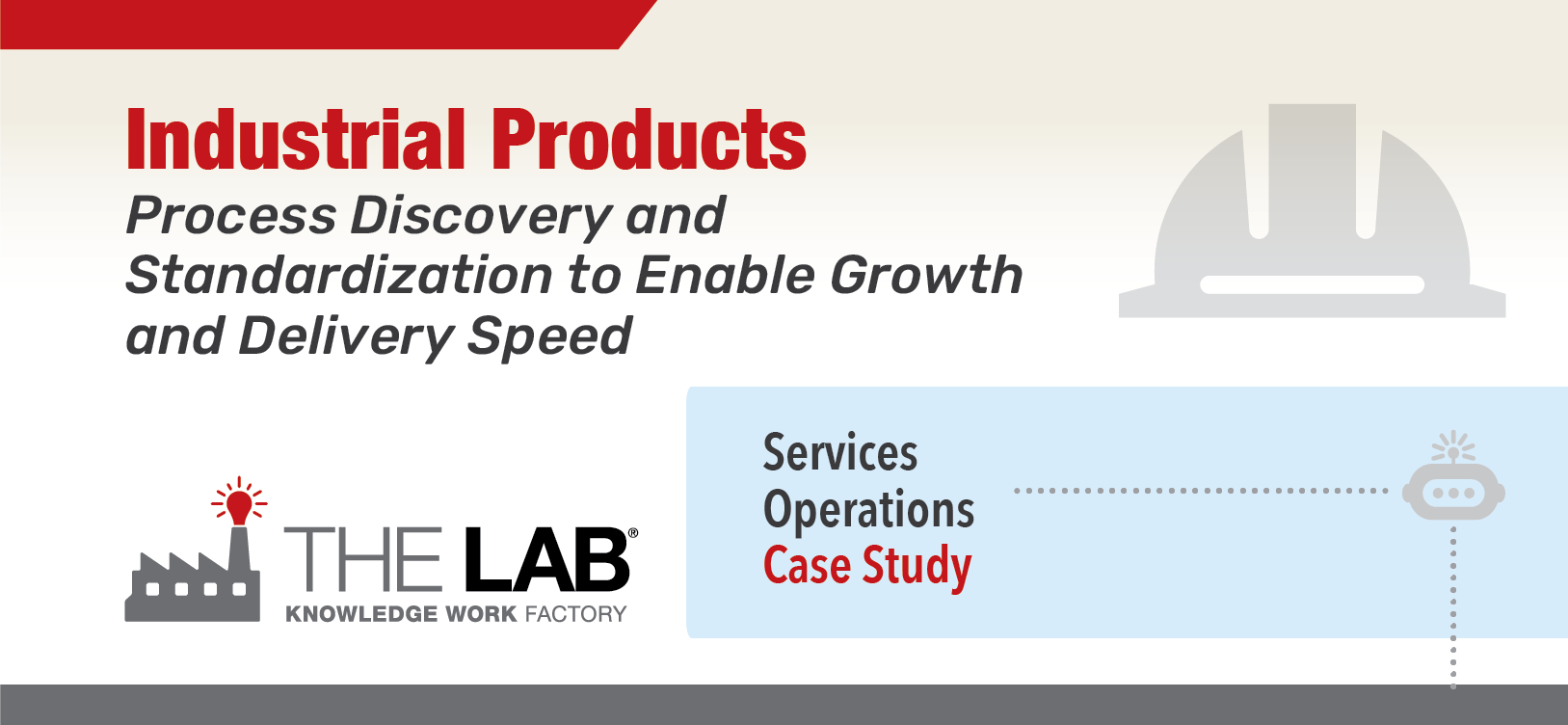Standardization and Automation Needed to Retain “One-Stop Shop” Advantage
For two decades, the building products division of this company dominated its competitors by getting its premium quality products specified for new institutional construction projects. The initial sale was profitable; later replacement and maintenance service was even more lucrative. And the entire service offering was typically bundled with 24/7 alarm-monitoring services, providing a single “one-stop shop” advantage for far-flung global networks of businesses. But then disturbing news started arriving from the sales force: Architects were allowing contractors to ignore the specs and use substitute products. Maintenance service customers were doing the same. Competitors offered a 30-percent discount. Even worse, they delivered in five days or less—while the building products division struggled to deliver in three weeks. The company’s long-held strategic advantage as the industry’s ”one-stop-shop” was at grave risk. The executive team rapidly needed to improve performance—and deliver a plan within weeks.
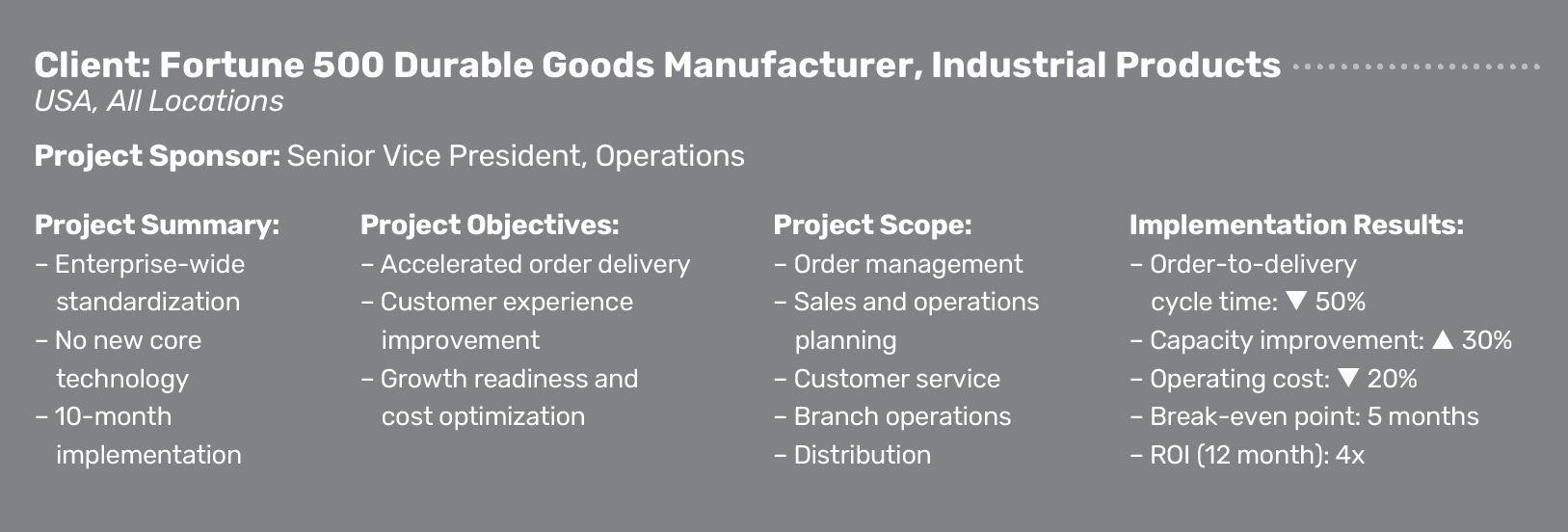
Client Description, Project Scope, Objectives
The company provides commercial building and security products as well as maintenance and monitoring services worldwide. More than 4,000 employees serve business and institutional customers in North America alone. The project scope included all non-manufacturing organizations in the supply chain: marketing, sales, distribution, customer service, and branch operations. The operations execs huddled for an afternoon at a company offsite and agreed to do everything in their power to hold on to the company’s dominant “one stop shop” position. They already knew that massive improvement was possible from simple strategies for automation that would not involve massive capital spending or board-level approvals:
• New automation technologies: Low-cost, low-code technologies were available (robotic process automation or RPA, AI, workflow, digital forms, etc.), that could be deployed quickly, with low risk and minimal disruption.
• Existing technologies: Massive, previous investments in sophisticated technologies were not used to their full potential, and often were used inconsistently across the enterprise. The executive team knew that “simple” does not mean “easy.” For example, a board of directors’ mandate from two years earlier to rapidly adopt robotic process automation enterprise-wide was struggling to make meaningful gains—only a dozen RPA bots were operational and improvement benefits were negligible.
The new initiative would depend on improving consistency. Operations were needlessly inconsistent, and everyone could see it. There were not enough objective facts about margins, performance, and especially the critical, end-to-end processes—no repository of standards, no single source of truth. Executives leaned on ad hoc analysis and tribal knowledge to support decisions. To get a more automated and data-driven supply chain, the execs knew that existing operations must become more standardized and coordinated. Someone joked that they needed an “industrial engineering” approach—like they had in the plants—for the services delivery operations.
The group learned that The Lab specialized in standardization-based improvement and automation. After reviewing The Lab’s process-improvement templates and supply-chain standardization methodology, they saw how these could simultaneously deliver two types of gains:
• Non-technology gains: Standardizing operations reduced the avoidable rework and needless variation that squandered 30 percent of everyone’s workday. Standardizing data intake, analysis, and reporting delivered consistent insights—from a “single source of truth.”
• Technology-enabled gains: Documenting these standardized operations revealed that 40 percent of the remaining work activities were candidates for some type of automation—either new, digital technologies (RPA, AI, etc.), or existing technologies (ERP, CRM, etc.).
Together, these represented a virtually endless list of strategically valuable, complementary, near-term improvement opportunities (both non-technology, and technology-enabled) that required no major new core IT systems.
The project was completed in two phases — over a 12 month period.
Phase I, Analysis and Discovery
Within eight weeks, The Lab’s standardized process map and discovery templates enabled documentation of all major end-to-end (E2E) business processes for 4,000 supply-chain and services employees. More than 85 percent of their work activities were analytically crowdsourced and documented. The templates enabled this detailed mapping while requiring only one hour per week of any subject matter expert’s (SME’s) time.
Next, The Lab’s standardization platform and data-science models mined, compiled, and generated insights for the maps from internal client applications: event logs, volumes, and cost-center data. The Lab’s external industry data provided benchmark comparisons, best-practice comparisons, and automation use-case comparisons. Coordinating and reconciling the E2E maps with both internal and external data resulted in improvement recommendations that could easily be directly reviewed, refined, and validated by thousands of the supply-chain employees—even with the company’s overseas divisions, across the Americas, in Europe, and in Asia.

Phase II, Implementation
The ten-month Phase II implementation effort reduced order delivery cycle times by 50 percent in the near term with plans to meet competitors’ times within the following year. A promotional campaign was launched to better-introduce the company’s lower-priced product lines to architects and end users. Customer segmentation focused on the top three most profitable groups, enabling rapid response for service needs and refocusing both branch and field sales efforts on these core customers. The least profitable customers were segmented into groups that required repricing (increase) and/or “unbundling” to reduce over-service.
The Lab implemented the highest-priority standardization opportunities and automations that had been discovered, alongside the client’s internal resources. The senior executive sponsor of the initiative adopted a decentralized approach. Once improvement goals were established for each area and/or for each E2E business process, the organizations involved were free to perform the work with any mix of resources they chose: internal resources or The Lab’s resources.
Improvement Examples, Service and Distribution Standardization
The Lab implemented over 170 process-standardization opportunities to reduce variance and 20-plus automation candidates to increase service, productivity, and efficiency. Examples:
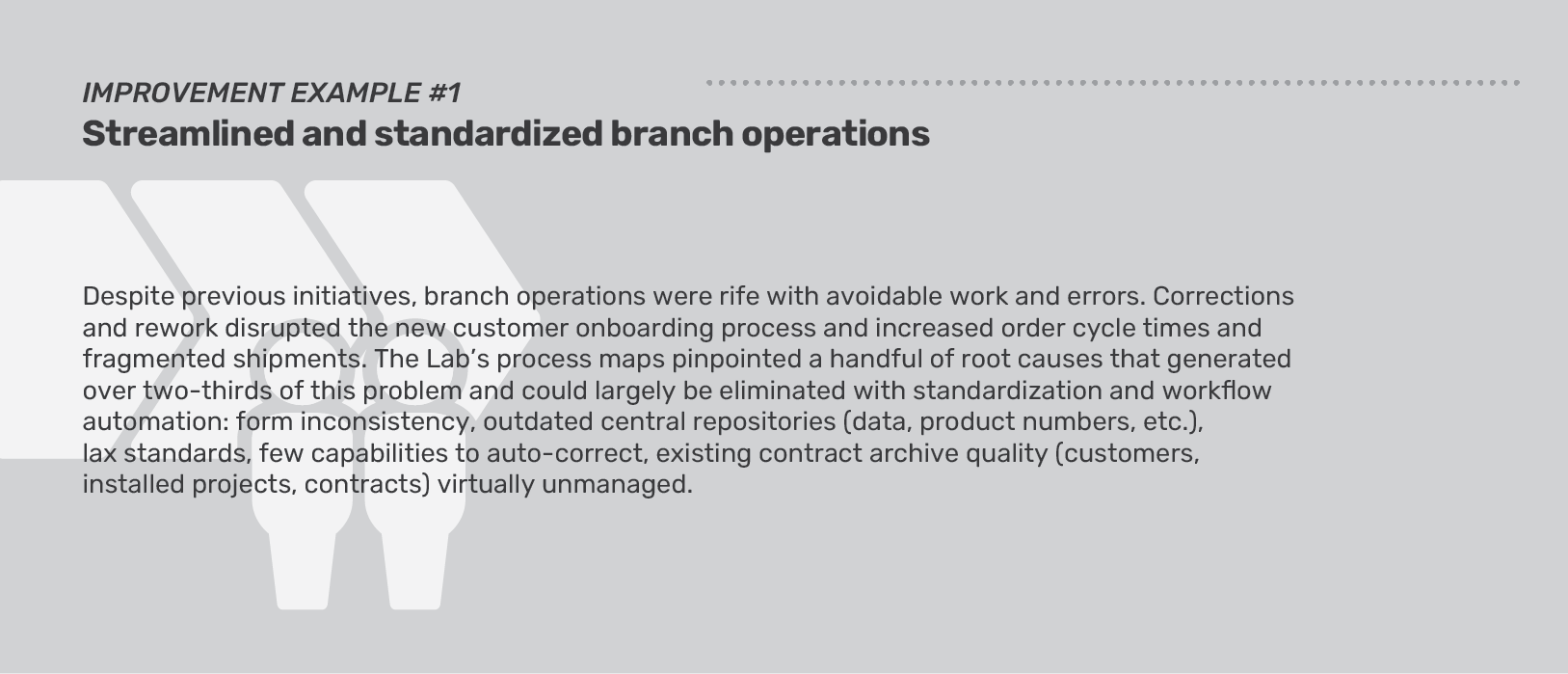
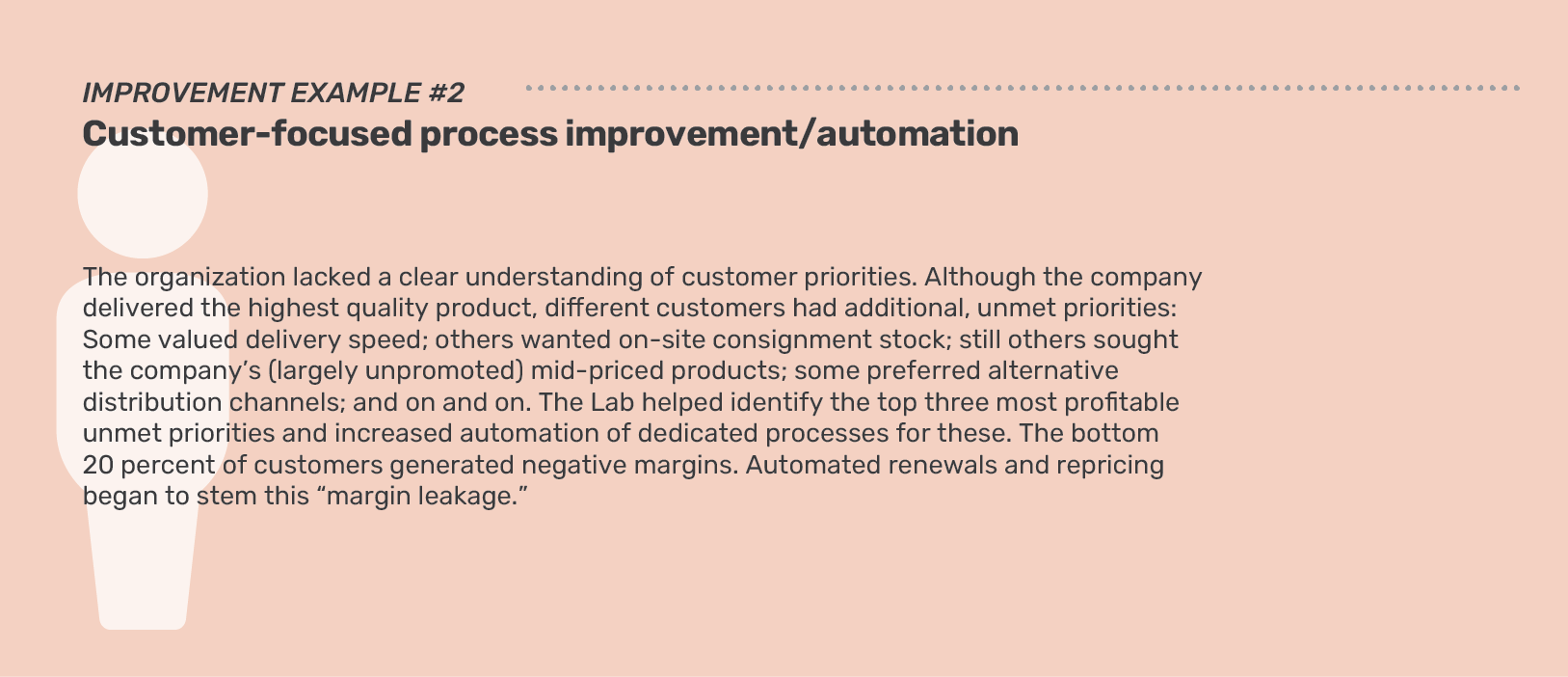
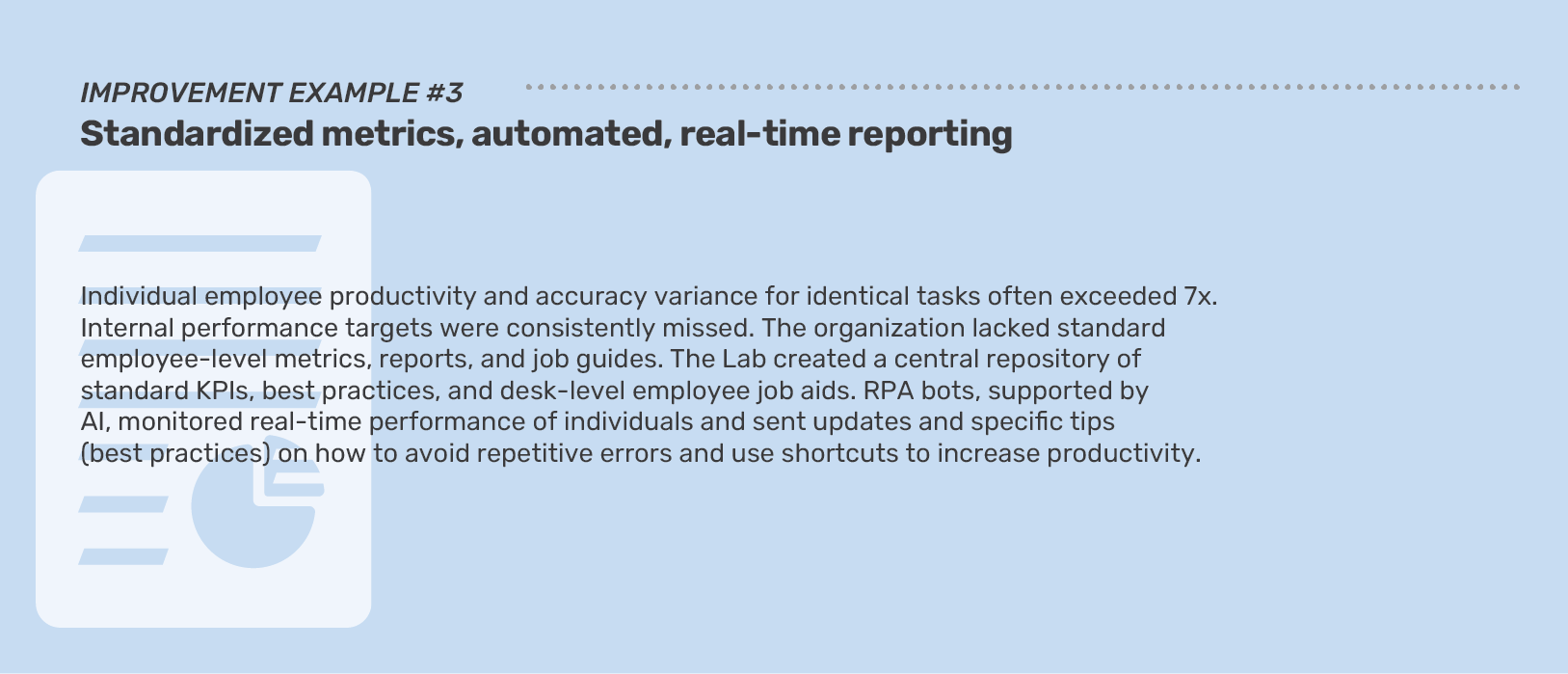
Post-Implementation, Sustainability, and Automation
The client needed hassle-free U.S.-based post-implementation sustainability support to maintain automations, process standardization, and operational data analytics models implemented during the Phase II engagement. The client’s team was not sufficiently up-skilled to perform needed automation updates or expansions, so they leaned on The Lab for Tier 3-level support. If analytics dashboards required additional visualizations or data-source connections, The Lab’s team was a simple phone call away.
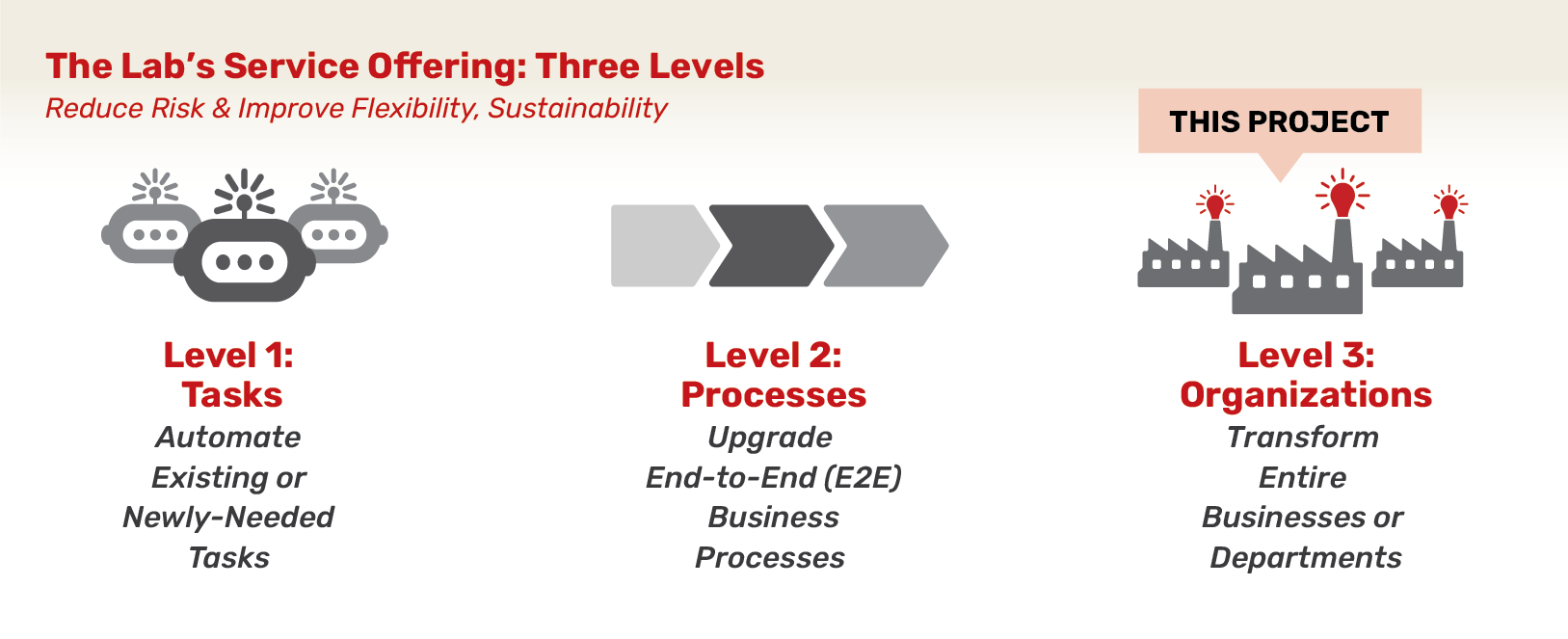
The Lab Makes it Easy
Organization-friendly engagement design
At The Lab, we’ve spent three decades refining every aspect of our transformation engagement model. We’ve made it easy for clients—from the C-Suite to the front line—to understand and manage the initiative:
• Minimal use of client time: One to two hours each week, maximum.
• Measurable benefits: Typical 12-month ROI is 3x to 5x.
• Pre-built templates and tools: Process maps, data models, bots, and more.
• U.S.-based, remote delivery: Nothing is ever outsourced or offshored.
Designed to reduce risk, increase success
Since 1993, The Lab has led the industry in eliminating risk for our clients. Whether your engagement involves a handful of bots or wall-to-wall transformation, we make it easy to do business with us:
• Fixed pricing and clearly defined scope
• Pre-project feasibility/value assessments at nominal cost
• Early-out checkpoints and options
• Money-back guarantees
Book your free demo
The best way to learn about The Lab’s patented Knowledge Work Standardization® approach is to book your free, no-obligation 30-minute screen-sharing demo. And you’ll get all your questions answered by our friendly experts. Simply call (201) 526-1200 or email info@thelabconsulting.com to book your demo today!
















